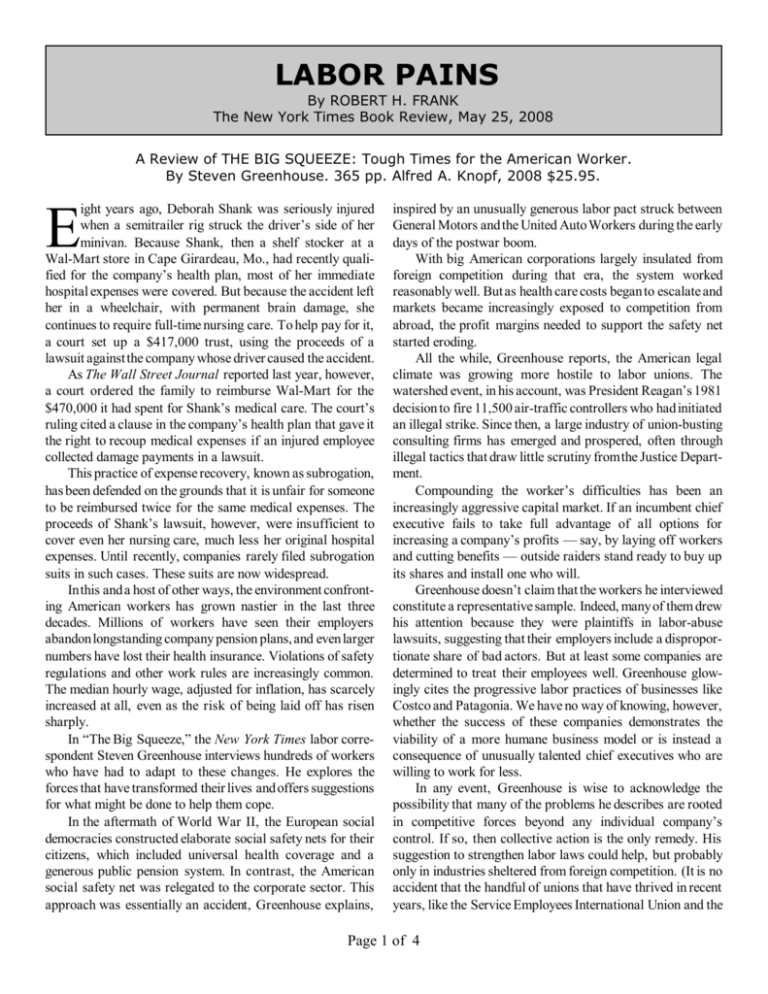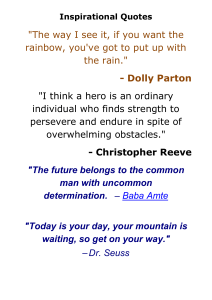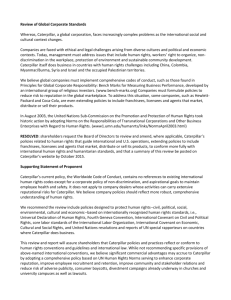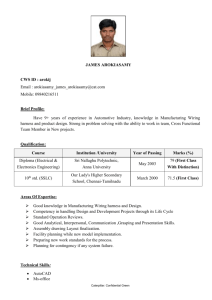Labor Pains
advertisement

LABOR PAINS By ROBERT H. FRANK The New York Times Book Review, May 25, 2008 A Review of THE BIG SQUEEZE: Tough Times for the American Worker. By Steven Greenhouse. 365 pp. Alfred A. Knopf, 2008 $25.95. E ight years ago, Deborah Shank was seriously injured when a semitrailer rig struck the driver’s side of her minivan. Because Shank, then a shelf stocker at a Wal-Mart store in Cape Girardeau, Mo., had recently qualified for the company’s health plan, most of her immediate hospital expenses were covered. But because the accident left her in a wheelchair, with permanent brain damage, she continues to require full-time nursing care. To help pay for it, a court set up a $417,000 trust, using the proceeds of a lawsuit against the company whose driver caused the accident. As The Wall Street Journal reported last year, however, a court ordered the family to reimburse Wal-Mart for the $470,000 it had spent for Shank’s medical care. The court’s ruling cited a clause in the company’s health plan that gave it the right to recoup medical expenses if an injured employee collected damage payments in a lawsuit. This practice of expense recovery, known as subrogation, has been defended on the grounds that it is unfair for someone to be reimbursed twice for the same medical expenses. The proceeds of Shank’s lawsuit, however, were insufficient to cover even her nursing care, much less her original hospital expenses. Until recently, companies rarely filed subrogation suits in such cases. These suits are now widespread. Inthis and a host of other ways, the environment confronting American workers has grown nastier in the last three decades. Millions of workers have seen their employers abandonlongstanding company pension plans, and evenlarger numbers have lost their health insurance. Violations of safety regulations and other work rules are increasingly common. The median hourly wage, adjusted for inflation, has scarcely increased at all, even as the risk of being laid off has risen sharply. In “The Big Squeeze,” the New York Times labor correspondent Steven Greenhouse interviews hundreds of workers who have had to adapt to these changes. He explores the forces that have transformed their lives and offers suggestions for what might be done to help them cope. In the aftermath of World War II, the European social democracies constructed elaborate social safety nets for their citizens, which included universal health coverage and a generous public pension system. In contrast, the American social safety net was relegated to the corporate sector. This approach was essentially an accident, Greenhouse explains, inspired by an unusually generous labor pact struck between General Motors and the United Auto Workers during the early days of the postwar boom. With big American corporations largely insulated from foreign competition during that era, the system worked reasonably well. But as health care costs beganto escalate and markets became increasingly exposed to competition from abroad, the profit margins needed to support the safety net started eroding. All the while, Greenhouse reports, the American legal climate was growing more hostile to labor unions. The watershed event, in his account, was President Reagan’s 1981 decision to fire 11,500 air-traffic controllers who had initiated an illegal strike. Since then, a large industry of union-busting consulting firms has emerged and prospered, often through illegal tactics that draw little scrutiny fromthe Justice Department. Compounding the worker’s difficulties has been an increasingly aggressive capital market. If an incumbent chief executive fails to take full advantage of all options for increasing a company’s profits — say, by laying off workers and cutting benefits — outside raiders stand ready to buy up its shares and install one who will. Greenhouse doesn’t claim that the workers he interviewed constitute a representative sample. Indeed, manyof them drew his attention because they were plaintiffs in labor-abuse lawsuits, suggesting that their employers include a disproportionate share of bad actors. But at least some companies are determined to treat their employees well. Greenhouse glowingly cites the progressive labor practices of businesses like Costco and Patagonia. We have no way of knowing, however, whether the success of these companies demonstrates the viability of a more humane business model or is instead a consequence of unusually talented chief executives who are willing to work for less. In any event, Greenhouse is wise to acknowledge the possibility that many of the problems he describes are rooted in competitive forces beyond any individual company’s control. If so, then collective action is the only remedy. His suggestion to strengthen labor laws could help, but probably only in industries sheltered from foreign competition. (It is no accident that the handful of unions that have thrived in recent years, like the Service Employees International Union and the Page 1 of 4 American Federation of State, County and Municipal Employees, represent service workers and government employees, whose jobs cannot be easily shipped abroad.) But as the experience of the automobile, steel and other manufacturing industries has demonstrated, strong unions can accomplish only so much. Thebad news isthat intoday’s hyper-competitive climate, the corporate sector is no longer able to administer the nation’s social safety net. Government is really the only alternative. The good news is that the American economy still has the largest G.D.P. in the world — much more than enough to support a high standard of living for shareholders, managers and workers alike. As Greenhouse observes in his closing chapter, the components of an efficient social safety net are reasonably well understood. For instance, we could easily afford a single-payer health system like the one in France, which covers everyone and delivers better health care for about half the amount we now spend per capita. We could easily afford to supplement the American Social Security system, which transfers income from workers to retirees, by establishing a national retirement savings plan in which a portion of each worker’s wages was deposited in a tax-sheltered investment account, enablingfamilies to take full advantage of themiracle of compound interest. Wehave ample resources to supplement lagging wages by raising the Earned Income Tax Credit, which Ronald Reagan called the most effective antipoverty program ever devised by Congress. And we could easily reduce the college- tuition burden on low-in-come families by expanding the existing program of Pell Grants. Skeptics invariably counter that the taxes needed to pay for an expanded social safety net would cripple the economy byweakening people’s incen-tives to work hard and take risks. Yet there are many ways to raise additional tax revenue that would actually cause G.D.P. to grow rather than shrink. A tax on carbon and other environmental pollutants, for example, would raise substantial revenue and yield a cleaner, more sustainable environment. Congestion taxes would save millions of hours currently wasted in traffic jams. A progressive income tax that exempts savings would divert billions of dollars from wasteful mine-is-bigger spending contests. As Greenhouse’s interviews vividly remind us, no economic system can prosper in the long run if people who work hard and play by the rules cannot meet their basic needs. The workers profiled in “The Big Squeeze” cannot afford to pay for health care or to send their children to decent schools. And precisely because of their precarious economic position, their sons and daughters are far more likely than others to go into the military. Six days after the subrogation order was issued against Deborah Shank, the family learned that their 18-year-old son, Jeremy, had been killed on duty with the Army’s 25th Infantry Division in Iraq. Last month, stung by unfavorable publicity, Wal-Mart abandoned its effort to be reimbursed for Shank’s hospital expenses. Even so, it’s little wonder that surveys find so many American workers yearning for an election that could produce genuine change. Robert H. Frank, an economist at the Johnson School of Management at Cornell University, is the author of “Falling Behind: How Rising Inequality Harms the Middle Class.” An excerpt from “The Big Squeeze” STARTING OUT MEANS A STEEPER CLIMB The Nation Magazine • May 12, 2008 Young workers face lower wages and higher costs than their parents' generation. by STEVEN GREENHOUSE F rom 7am to 3pm each day, John Arnold darts around Caterpillar's "materials-handling facility" in his forklift, maneuvering it with the deftness of a NASCAR driver. His job is to unload tractor parts from flatbed trucks and then deposit those parts—from engine gaskets to one-ton tractor buckets—in the huge store yard at the plant, just east of Peoria, Illinois. An earnest, deep-voiced giant of a man, Arnold likes his job, with one major reservation – twentysomethings like him can earn only three-fourths as much as the fiftysomethings who work alongside him. Under the two-tier contract at Caterpillar, the most Arnold can ever earn is $14.90 an hour, or $31,000 a year—so little, he says, that some of his co-workers are living at home with their parents. "Some," he said, "are even on food stamps." A52-year-old who works alongsideArnold, doing exactly the same work, earns $19.03 an hour, or just under $40,000 a year, because employees who started before Arnold beganin 1999 are on a higher wage scale. "I don't like it," Arnold said. "I wish I was at least able to get to the pay scale that the guys who are right next to me are making." Scott Wilcoxon, a 26-year-old Navy veteran who not long ago served as an electrician on a nuclear submarine, operates five computer-controlled metal-cutting machines at Caterpillar. The maximum he can ever earnis $19.84 an hour, Page 2 of 4 21 percent below the maximum for the 50-year-olds working next to him. Wilcoxon says it's a struggle to support his wife and three children. "We can buy our food and our gas," he says. "But we can't go out to eat at a nice restaurant. We can't go to a movie. We can afford very few extras." Caterpillar, based in Peoria, is an enduring symbol of America's industrial prowess, thanks to the success of its earth-moving machinery. At the end of World War II, the US Army left behind thousands of Caterpillar tractors to help Europe and Asia rebuild, a gesture that ultimately established Caterpillar worldwide. For decades the company reigned as the king of tractor production, and its factories in and around Peoria paidsome of the best wages in the American heartland. In the late 1980s, Caterpillar's factory workers earned $16 an hour on average, equivalent to $28 an hour in 2007 dollars. "My dad has worked at Caterpillar for thirty-seven years, and when I was a kid, he was making some good money," Arnold said. "I was hoping that I could eventually get to where my dad's at." His father, a millwright who repairs conveyor belts and other machinery, works in the same giant materials-handling facility and earns $25 an hour, nearlytwice as much as his son. (Arnold's pay is lower than his father's not just because he is on the lower tier of a two-tier pay scale but also because he works in a less-skilled pay grade.) John Arnold and Scott Wilcoxon are the type of workers on whom America's industrial success was built: diligent, dedicated and determined. But because their wages are lower than those of the previous generation, they are part of a reverseeconomic evolution unfolding atworkplaces across the country: at General Motors, Ford and Chrysler; the Dana Corporation's more than two dozen auto parts plants; American Axle's two plants in upstate New York; ACF's railcar plant in Pennsylvania; and longshoremen's hiring halls along the East Coast. Since manufacturing companies have pushed hardest for a lower-wage tier for young workers, this phenomenon is most prevalent among the nation's 13.7 million factory workers. Caterpillar began insisting on a lower-wage tier in the early 1990s. After losing more than $1 billion in the 1980s, in part because of lower prices offered by Komatsu and other foreign competitors, Caterpillar decided to take a hard line in bargaining with the United Auto Workers. Convinced that it needed to cut costs, the company demanded a dual wage scale that would pay new workers 60 percent less than experienced workers earned. The UAW resisted those demands and called a strike by 12,000 Caterpillar workers in late 1991. After five months, Caterpillar emerged victorious and instituted a system that paid new workers 20 to 40 percent less than the other workers received. In Caterpillar's parlance, the lower pay scale is called "a competitive wage"—not so high that Caterpillar becomes uncompetitive against foreigntractor makers yet high enough to attract the workers it needs. The company seems confident that its pay strategy will assure its future as a thriving company. But Wilcoxon’s wife, Anessa, views the competitive wage from a different perspective. "My parents' house was bigger," said Anessa, whose father worked for Caterpillar for three decades. "We always had two cars when I was growing up. When we went out to eat—we had a family of five—we'd always go to a sit-down place. When we go out to eat now, it's McDonald's or Hardee's." The Wilcoxons rent a run-down three-bedroom house and have a second car only because Anessa's parents gave them their old GMC Sierra truck. Caterpillar's CEO, Jim Owens, says the company's competitive wage strategy isn't destroying middle-class jobs so much as it's preserving jobs in America. If Caterpillar did not maintainits competitive wage rates, Owens says, his company would be closing plants in the United States or moving operations overseas, or perhaps both. But thanks to its competitive wages, Owens says, Caterpillar has been able to increase its Midwest workforce, expanding it by 5,000 in 2005. "What we've done is reposition ourselves to actually grow employment in our Midwestern plants," Owens said. "We finally have a labor cost that is viable." Caterpillar's posture points to a rough future for millions of young Americans who may someday want factory jobs, jobs that workers without college degrees embraced in decades past to lift themselves into the middle class. Not long ago, the typical compensation package for unionized factory workers in the Midwest was $40 an hour, including benefits. But according to Daniel Luria, an economist at the Michigan Manufacturing Technology Center, that package is now around $25 an hour—$13–$18 an hour in wages plus $9 or so in benefits. Among young workers at Caterpillar, the company's two-tier wage scale has engendered huge resentment. "Caterpillar," Wilcoxon said, "has monthly business meetings in the factory where managers talk about how the company is doing. They talk about their record sales and record profits, and we sit there, and they wonder why we're still bitter about the contract. I sometimes call those monthly meetings our monthly slap in the face. And each year the top executives' salaries are printed on the front page of the newspaper. They may not mean to, but it feels like they're rubbing it in our faces." Recently, Caterpillar has piled up record earnings. Its netprofits soared to $3.5 billion in 2006, up 74 percent from two years earlier. Those profits amount to $37,000 per employee, almost as much as Wilcoxon earns each year, convincing him and many other young workers that Caterpillar can easily raise wages without jeopardizing its competitiveness. Shane Hillard, a 29-year-old who works at the same factory as Wilcoxon, said, "I don't understand how you're Page 3 of 4 supposed to be able to buy a house and live the American dream when you work for one of the biggest companies in the United States and it's paying you just $12 an hour." America has always stood for progress, for economic advancement and upward mobility. But for many of today's young Americans, progress seems uncertain because entry-level wages and benefits have languished while housing costs and college tuition have risen. As one expert put it, "The next generation is starting their economic race fifty yards behind the starting line." Entry-level wages for college graduates and high school graduates fell from 2001 to 2005, after factoring in inflation, and median income slipped in families with at least one parent aged 25 to 34. Today's young workers face these wage problems because they are the first generation to come of age after the high-tech bubble burst, after offshoring jobs to India and elsewhere became popular, and after millions of factory jobsdisappeared in a new wave of deindustrialization. "Young workers are on the cutting edgeof experiencing all the changes in the economy," said Lawrence Mishel, president of the Economic Policy Institute. Longer-term wage trends have been just as troubling. From 1979 to 2005, entry-level wages for male high school graduates without college degrees slid 19 percent (after inflation); for their female counterparts, they fell 9 percent. For young Americans with college degrees, entry-level wages did rise, although modestly and still far slower than wages for most older workers with college degrees. Onestudy found that men who were in their 30s in 2004 had a median income 12 percent less, after factoring in inflation, than their fathers' generation did when they were in their 30s. The changing job market is undercutting entry-level wages for those who do not go to college. "In the 1960s and 1970s, you saw high school graduates getting good jobs at Ford and AT&T, jobs that in inflation-adjusted terms were paying $20 or $25 in today's wages," said Sheldon Danziger, a professor of public policy at the University of Michigan. "Nowadays most kids with just high school degrees will work in service-sector jobs for $10 or less. That's where you see a big drop." All told, a bit more than one in four of the 45 million workers under 35 does not have health insurance from any source, by far the highest rate of any age group. As for young workers with just high school degrees, two-thirds do not receive health coverage in their entry-level jobs, up from just over one-third in 1979. Corporate America's increasing tightfistedness over pensions is also hitting young workers hard. The share of workers 25 to 34 participating in an employer-sponsored pension plan or 401(k) slid to 42 percent in 2005, down from 50 percent fiveyears earlier. As for workers aged 35 to 64, 55 percent participate in employer-sponsored retirement plans. The picture is worst for young high school graduates; fewer than one in five participates in a retirement plan in an entry-level job. Frustrated by his economic situation at Caterpillar, Scott Wilcoxon has enrolled in an online college program with Colorado Technical University. He was a star student in high school, studying two foreign languages and planning to major in physics in college. But he fell in love with Anessa, married at 18 and suddenly had a child to support. He joined the Navy instead of going to college because that enabled him to serve his country while his military pay supported his family. With the Navy now providing tuition assistance, he has decided to pursue a bachelor's degree in business, specializing in human resources. He used to dreamof becoming a teacher, but he has since decided against it because "teachers don't exactly make enough to support a family of five." Now he hopes to work for a large corporation, training employees on mechanical operations. That way he can still teach, while earning more than a public school teacher. Many nights after he returns home from Caterpillar at 11:30 PM, Wilcoxon studies until 1:30 AM. Sometimes he even hits the books during his half-hour lunch break at Caterpillar. "I've reached the top of the unskilled job market," Wilcoxon said. "This is the only thing that's going to allow us to get out of this upper-lower-class way we live." Steven Greenhouse has been the labor and workplace correspondent for the New York Times since 1995. This article is excerpted from his new book, The Big Squeeze: Tough Times for the American Worker. Copyright © 2008 by Steven Greenhouse. The Big Squeeze examines the problems faced not only by young workers but also high-tech workers, blue-collar workers, freelancers, Wal-Mart workers and many other types of workers. ################# The Big Squeeze: Tough Times for the American Worker by Steven Greenhouse (2008, Alfred A. Knopf ) is available at your local bookstore or can be ordered online via one of the only unionized booksellers in the nation –Powell’s Books (represented by ILWU Local 5). Starting your order through the following link generates 10% for Powell’s workers themselves: www. powells.com/ppbs/23956.html .You can subscribe to the Nation magazine at www.thenation.com. A full year’s subscription to 47 weekly print issues with online access and four free issues is $32. A 47 week online-only subscription is $18. Page 4 of 4








